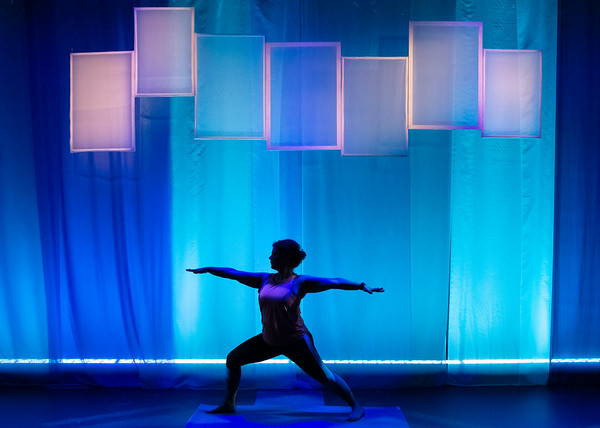Review: Poppers and Praxis: “Blue Seal, Blue Sea” is Ecstatic Queer Archival Artistry
Blue Seal, Blue Sea (or, gay boy grieves death of gay-hating dad)
Written and performed by Dante Fuoco
Directed by Clara Wiest
Presented at The Makers’ Space
13 Grattan St. #408, Brooklyn, NYC
November 6-23, 2025
 |
| Dante Fuoco in Blue Seal, Blue Sea. Photo by Dev Hardikar. |
Dante Fuoco’s inspired one-man Blue Seal, Blue Sea treats the archive as a living medium, something that shifts and pulses according to who is brave enough to hold (or huff) it. This is brave, bold, important work, and Fuoco soars (and manages one hell of a plié).
The action begins when F@gg’aught Flamé (Dante Fouco) hits the popper (hard) and enters an induced dream-cum-bedroom, functioning as the mind’s strange archival antechamber, a place where memory is destabilized and accessible. A recovered relic, Grandma’s Creepy Porcelain Doll, names the production’s cosmology outright. The space is “the land of what’s remembered, what’s forgotten, and what’s recorded,” a descriptor that is equal parts invitation and warning. Fuoco uses that psychic geography with aplomb to examine how a child’s interior life survives inside a household that never understood how to nurture it.
 |
| Dante Fuoco in Blue Seal, Blue Sea. Photo by Dev Hardikar. |
The pop-sequence that opens the piece arranges, in succession, New Radicals (“You Get what you Give”), Christina Aguilera (“Genie in a Bottle”), Britney Spears (“Baby (One More Time)”), Haddaway (“What is Love?”), and, ultimately, Celine Dion (“All by Myself”) as a coded queer emotional ledger. Amidst F@gg’aught Flamé’s chaotic costume of explosive colors and unlikely layers, lip-syncing, and giddy dance, these anthems are not the stuff of mere middling nostalgia. Rather, they operate as encrypted evidence of a queer kid trying to translate intensity without the vocabulary to express it. The family dinner scene that follows quickly reveals its false front, and the room begins to mutate. The TV behaves like a portal one moment and a broken prop the next. What seems funny or absurd gradually reveals the instability of memory, of an archive distorted by fear, secrecy, and adult refusal.
Dante Fuoco’s physical performance embodies this instability with remarkable precision. Deft direction by Clara Wiest has Fuoco undulating between childlike impulse and adult comprehension without exaggeration or apology, choosing instead to let the body show how memory feels. A hand flutter becomes a whole childhood. A shift in weight becomes a moment of adult recognition. He plays F@gg’aught Flamé as someone who can be eager, petulant, terrified, and redeemed in the span of a breath, rendering the performance nothing short of heartbreaking. The body keeps the score, remembering, even when the mind hesitates. Fuoco lets this truth guide him, and the result is an uncompromisingly physical performance that refuses to choose between vulnerability and authority.
Six VHS tapes become six attempts to document a life never cleanly documented. Each tape belongs to a different archival mode. Home-video tenderness collides with audio bleed from another room. A family argument reappears as a crime scene once replayed with adult clarity. The interrogation sequence dissolves into a sexual fantasy that exposes how shame, desire, and survival can and often do sit inside the same memory. The piece keeps returning to the same ethical questions: What does it cost to replay what harmed you, and what does it cost never to look at it again?
 |
| Dante Fuoco in Blue Seal, Blue Sea. Photo by Dev Hardikar. |
Inside these tapes sits the ballet thread, quiet at first, then unmistakable. Ballet emerges as the counter-archive. The father’s contempt for queerness often mirrors his disdain for dance, yet the footage tells another story. “I wanted to do ballet but my father wouldn’t let me… I loved how I looked and how I danced… She did it so I could dance… And I loved dancing. I loved dancing.” The line lands with such simple force because it reveals the hidden care that existed in the household, a care the father tried to suppress and the mother tried to protect. Ballet becomes proof of a self that was visible, vibrant, and briefly permitted to breathe.
This prepares the ground for the performance’s final gesture. When F@gg’aught Flamé appears in a ballet skirt near the end, the image feels less symbolic than documentary. The body continues what the tapes have already established. The dance is not a metaphor for healing. It is the archive made physical, interpenetrating space. It is a body returning to the movement that once gave it freedom. The skirt, the turns, the reach of the arms, all function as a refusal to let the past remain in storage. F@gg’aught Flamé does not re-create what was lost. He completes what was interrupted.
The last VHS does not merely bookend but binds everything together. Beach footage, ashes, Fiona Apple, and chosen family gather into a funeral that the biological family never gave. The performer speaks to his father with precision, not contrite absolution. The clarity of the moment feels ceremonial, insisting that grief does not require forgiveness. Instead, it requires memory and accuracy, and the entire performance becomes an act of queer recovery or perhaps rememory, a way of arranging the archive so that the living body can move inside it again.
-Noah Simon Jampol



Comments
Post a Comment